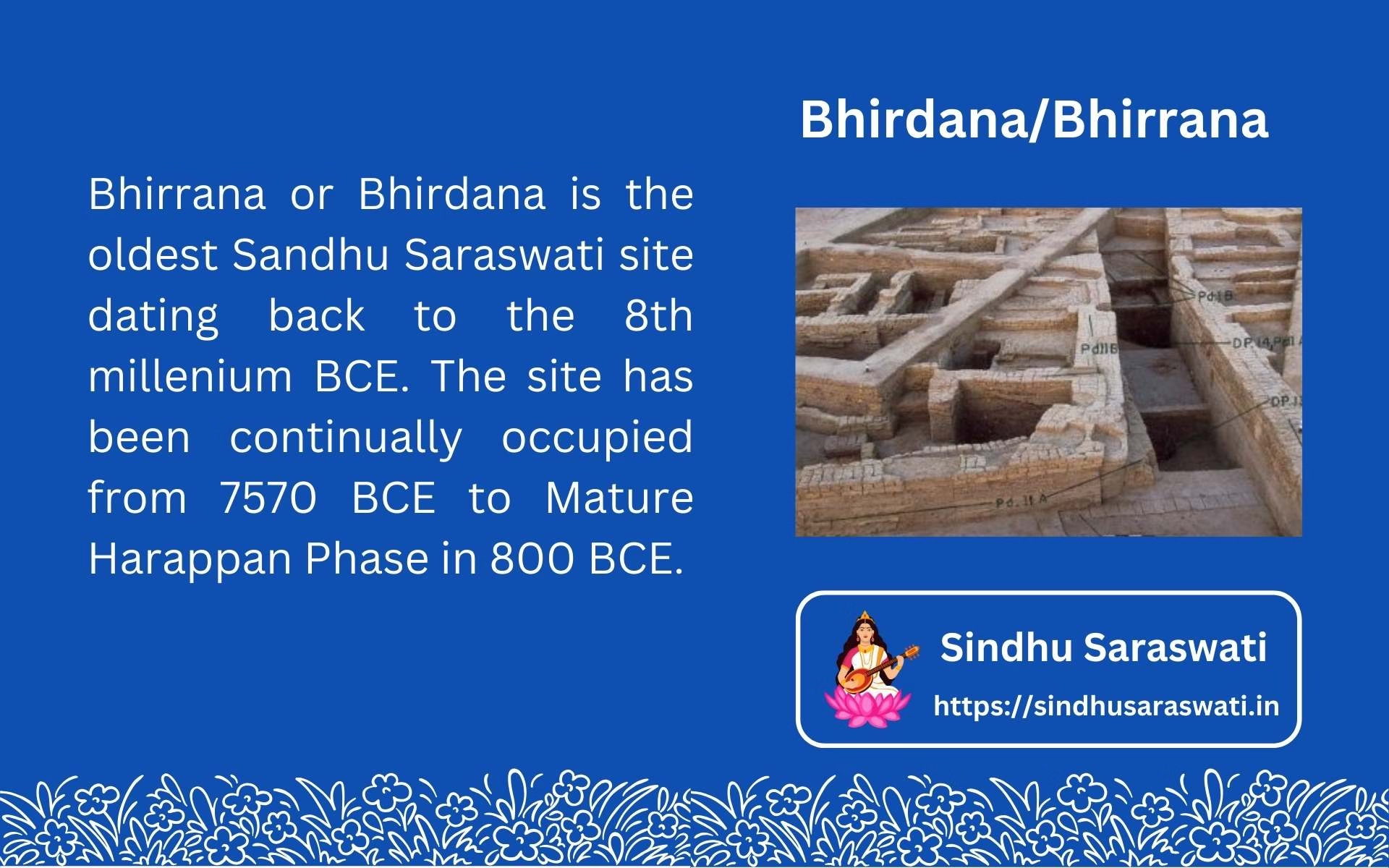The Bhirdana (also written as Bhirrana) archaeological site was inhabited from 7570 BCE to 800CE, making it one of the oldest, yet continually inhabited sites in the world.
Discovered by L.S. Rao and his team of researchers in 1997. The excavations continued till 2005.
In summary, Bhirrana yielded all the materials corresponding to the individual eras of Neolithic, Hakra Ware, pre-Harappan, Early Harappan, Mature Harappan, and post Vedic era (800 BCE).
What perplexes researchers about this site is its existence till post Vedic period, i.e., 300 years after the supposed Bronze Age Collapse.
Phases of Inhabitance
The site at Bhirrana was continually inhabited from the Neolithic culture in 7570 BCE (similar site in Cholistan) to the post Vedic era in 800 BCE.
It has exhibited materials in its layers that relate to all phases of the Sindhu Saraswati civilization.
Pre-Pottery Neolithic Era
Hakra Ware Culture
The Hakra Ware culture is a distinct material culture associated with wide shouldered pots made using pottery wheels from under fired clay. These pots were colored with black and shades of light gray.
In Bhirdana, the oldest layer of excavated material shows that
Early Harappan
In the Early Harappan phase, Bhirdana yielded mud pit dwelling where yellow alluvial soil from the Saraswati river was used to plaster the bottom of the pits.
Materials excavated from this period yielded:
- a copper bangle
- a copper arrowhead
- terracotta bangles
- beads of carnelian
- lapis lazuli, which could have only come from Shortughai region
- steatite, a soft stone
- stone saddle
- quern
- bone point
Mature Harappan
The mature Harappan phase has been divided into two sub-phases of Early Mature Harappan and Mature Harappan by L.S. Rao.
Early Mature Harappan
The Early Mature Harappan phase saw a drastic change in city planning with the earlier mud-pit dwelling being transformed into proper planned cities in this phase.
Sun-baked brick structures were found in this phase with alignment with “True North”, with a slight deviation. Proper lanes and by-lanes also came into existence.
Pottery from this phase show a mix of Early Harappan and Mature Harappan pottery.
Valuable items from this period in Bhirdana yielded two caches of beads containing semi-precious stones like Lapis Lazuli.
Other items included:
- Bangles of Copper
- Shell (Cowries?)
- Terracotta and Faience
- Fish Hook (proved a marine organism based diet and possible pisciculture)
- Chisel (proves extensive stone and wood working)
- Arrowhead of copper
- Terracotta animal figurines (probably toys)
Late Mature Harappan
In the Late Mature Harappan phase, Bhirdana was probably a vast city in the Sindhu Saraswati civilization.
The Mature Harappan phase yielded similar materials as the Early Harappan layer at Bhirdana, signifying a continuity in existence.
These artefacts were:
- bangles of copper, terracotta, faience, and shell (Shankha)
- seals of steatite, a common occurrence in Sindhu Saraswati sites
- inscribed celts of copper
- bone objects
- terracotta spoked wheels
- terracotta animal figures (probably toys)
- beads of
- lapis lazuli
- steatite
- carnelian
- agate
- faience
- stone
- terracotta
Dancing Girl Graffitti
Bhirdana also yielded a “dancing girl” inscribed on a potsherd (probably a part of a ceremonial pot). This potsherd containing the image of the dancing girl (possibly a deity, or an Apsara) was almost identical to the one discovered in Mohanjodaro.
According to the excavator, L.S. Rao, the likelihood of the broze statue and the potsherd apsara being representation of the same “dancing girl” is high.
According to my own experience and knowledge, it is highly likely that the bronze dancing girl was used as a temple statue (major or minor deity) and the inscribed image of the same “dancing girl” or “apsara” on a potsherd served the worship probably inside a household.
Researchers and Research Papers
L.S. Rao wrote an extensive paper on the discovery of Bhirrana. He mentioned the details of excavations which yielded artefacts belonging to all the Sindhu Saraswati civilization periods.d
Below is the PDF.




